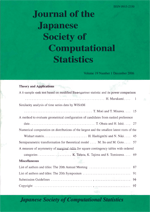Volume 23, Issue 1
Displaying 1-4 of 4 articles from this issue
- |<
- <
- 1
- >
- >|
Theory and Applications
-
2010Volume 23Issue 1 Pages 1_1-1_12
Published: 2010
Released on J-STAGE: December 17, 2010
Download PDF (545K) -
2010Volume 23Issue 1 Pages 1_13-1_26
Published: 2010
Released on J-STAGE: December 17, 2010
Download PDF (260K) -
2010Volume 23Issue 1 Pages 1_27-1_40
Published: 2010
Released on J-STAGE: December 17, 2010
Download PDF (235K) -
2010Volume 23Issue 1 Pages 1_41-1_50
Published: 2010
Released on J-STAGE: December 17, 2010
Download PDF (213K)
- |<
- <
- 1
- >
- >|
